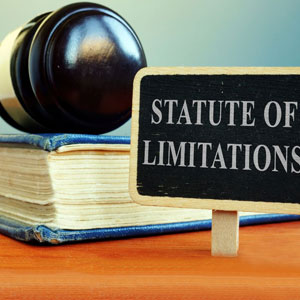
Have you been injured in a California car accident? If you have, you have the right to file a claim against the at-fault driver for any economic or non-economic damages you incurred (California Code of Civil Procedure Section 340). However, the law does limit when you can file a claim to seek monetary compensation for damages or injuries; it’s called the statute of limitations.
What Is a Statute of Limitations?
A statute of limitations is a law that defines a specific amount of time during which involved parties may initiate legal proceedings. The time generally begins when the incident occurs and the length of time allowed varies depending on the type of incident, the jurisdiction, and the nature of the offense.
What is the Statute of Limitations for California Car Accident Claims:
The statute of limitations for California car accident claims is two years from the date of the accident, with the time limit extended for minors until they reach the age of 18 years old (California Code of Civil Procedure Section 340).
What’s the Purpose of the Statute of Limitations?
The statute of limitations creates a legal time limit. The purpose behind creating a time limit for this type of legal proceeding is to preserve relevant evidence that enables the judge to determine fault. In many cases, determining fault relies heavily on the memory of witnesses, physical evidence from the accident, etc. since memories fade and physical evidence is often lost over time, it’s essential to address the legal claims soon after they occur.
What Happens If You File After the Statute of Limitations Passes?
If you don’t file your car accident claim during the two years allowed by the statute of limitations, injured adults are prevented from filing lawsuits. Very few exceptions to the time limit determined by the statute of limitations exist and are mainly limited to situations when the individual seeking to file lacks mental capacity. If you are injured in a car accident and attempt to file your claim after the deadline passes, your case may be dismissed by the Court. Unless your claim falls within the few limited exceptions, you will lose your chance to receive compensation for injuries or property damage.
What Issues Could Affect the Statute of Limitations for California Car Accidents?
Specific issues can affect the statute of limitations. For instance, if you are only seeking damage to repair damage to your vehicle or other property, the statute of limitations for California car accident claims is three years instead of two (according to California Code for Civil Procedure
Section 338). Another example occurs when a car accident involves a wrongful death claim. When a lawsuit is based on a death, the statute of limitations begins from the date of the death (even if it’s after the accident). When filing against a government entity, the time limit for the initial claim filing is six months, with a one-year time limit to file a lawsuit after the government entity denies the claim. Minors involved in car accidents are given additional time – the two-year limit created by the statute of limitations doesn’t begin until they reach the age of 18, not the date of the accident. Other issues that can affect the amount of time allowed for filing by the statute of limitations include a defendant who is in prison, out of state, or otherwise unavailable, lack of mental capacity, or injuries that left the victim incapacitated for a time after the incident, a defendant in bankruptcy, etc.
If you are injured and need to file a California car accident claim, contact Moss Bollinger, Sherman Oaks, California personal injury attorney. He’s dedicated to protecting and asserting the rights of his clients. Call (310) 982-2291 today for a free consultation, or contact us online.
Get Your Questions Answered. Call For Your
Free 30 Min Evaluation Today! (310) 982-2291